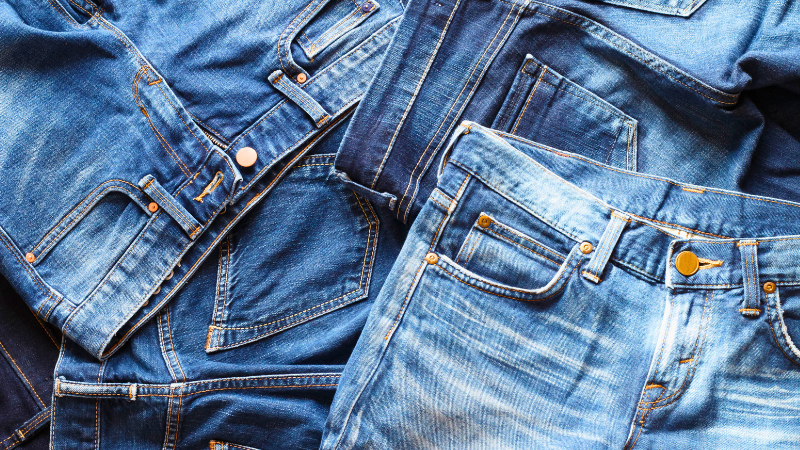
Denim is not limited to being just a wardrobe basics. It adds character to everything from your main pair of jeans to your favorite jacket which you never want to move away from. But have you ever considered what denim is, or why it is so much different from other materials?
Beneath the tough shell of the brand is its story, the key methods it uses and features that contributed to its long-term success. Keep going to see why people have kept wearing denim for so many decades.
What Is Denim?
What is denim exactly? Denim is basically a tough woven cloth created mainly from cotton fibers. Serge de Nîmes fabric is made with a particular twill called serge de Nimes and this gives it its characteristic rib pattern. Because of this diagonal texture, you can feel it on the surface and it strengthens and supports the fabric well.
You can recognize denim because the warp yarn (going side to side) is dyed in indigo to achieve the distinctive blue, while the weft yarn (going up and down) stays white. Such a difference makes real recycled denim special, which is why the outer layer is commonly blue and the inner layer often shows as white.
There is usually denim textile in jeans, jackets, trousers and various durable clothing items. It is tough, so denim cotton is ideal for use as everyday clothing, in youth fashions and for tough jobs.
What Is Denim Made Of?
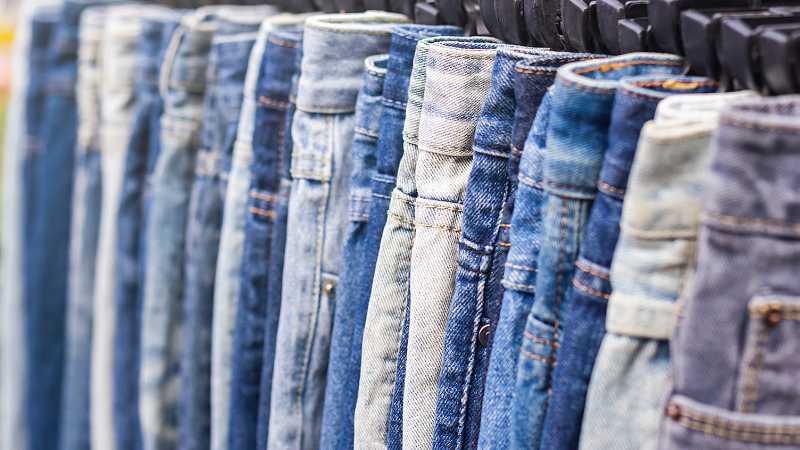
Let’s discuss now what materials are used to make denim. Traditional denim is made from only cotton, which is celebrated for how cool and easy to wear it is. The cotton is spun into threads and twisted into yarns, which are then woven on industrial machines that weave them together with the twill technique.
You can find modern styles of denim fabrics where cotton is combined with polyester or spandex (stretch denim), all to make the denim stronger, more flexible and softer.
That means garments are easier to take care of and wear, mainly for fitted jeans and activewear. Organic denim and denim made from recycled materials have gained many followers in the past few years because they help producers use organic cotton, recycled fabrics and help reduce harm to the environment.
Natural indigo is used to dye the warp yarns, so the weft yarns are white. It is this traditional method that keeps the special appearance of denim apart from other cotton fabrics.
Characteristics of Denim Fabric
Many factors in denim’s characteristics have helped it become a lasting favorite among people:
- Twill weave: The actual fabric has obvious diagonal lines or patterns because of its twill weave, which is a key feature in its look.
- Durability: Since denim products are made of durable twill weave, it is able to resist tears well, so it tends to last a long time in clothes.
- Cultural significance: For at least a century, denim has been a major item in American youth culture and wardrobes, and it has always been a part of their history and fashion.
- Personalized Fit: Wearing denim often leads to its softening and to it becoming tailored to the body, which provides a fitting and comfortable effect.
- Aging appreciation: Those who enjoy wearing denim enjoy the look of the fabric aging, which makes it look much nicer with time.
- Natural fading: Making untreated raw denim special is the unique way it begins to fade, which changes depending on the life and activities of the wearer.
- Breathability: Surprisingly, denim is able to breathe well and keep air flowing, which is possible because of the fabric’s cotton structure.
- Climate versatility: Denim is comfortable frequently and effortlessly, which is why it’s always found in people’s wardrobes for any time of year.
Types of Denim Fabric
Being able to tell the differences among denim fabrics is very important when purchasing jeans or a denim jacket. How a fabric feels, looks and wears is affected by its individual qualities. Here we will explain the differences in styles so you can pick the best for your needs.
Raw Denim

Raw denim is not washed or treated after it is made on the loom. Since the indigo cloth is not treated, the fibers are bunched tightly and the material looks very dark still. The jeans come to show your personal signs and fading on them as you move and live in them.
Being very active can sometimes leave creases and faint lines on your jeans in spots where you bend, for example at the knees. So, every relationship is different from the others. Raw denim is still able to save the environment, but it isn’t comfortable, flexible or easy to tailor yet.
Selvedge Denim
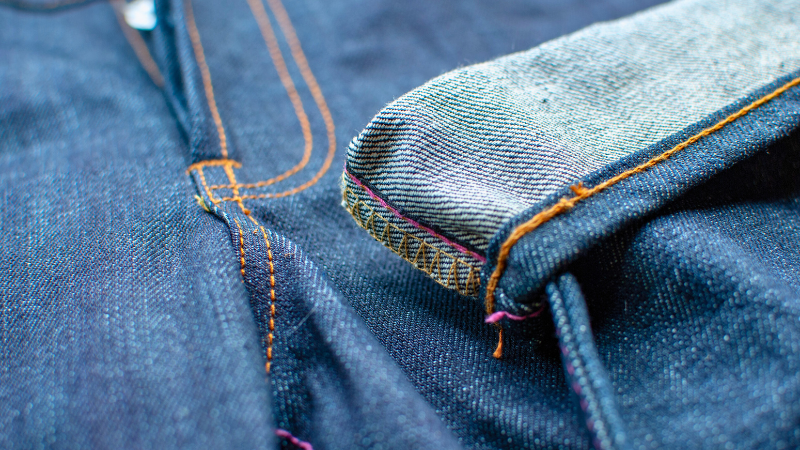
Selvedge denim is woven with shuttle looms, which are machines that weave slower than other types. The edge is smooth, clean and usually visible on the inside of jeans when the waistband is folded.
Compared to regular jeans, selvedge denim is thicker and more tightly packed, which makes it extra strong and well-made. Because of the durability and amazing fades, selvedge denim can be pricier; however, denim fans around the world love wearing them.
Stretch Denim

The addition of some spandex fabric to cotton in denim gives it extra flexibility and makes it supple. They are excellent for current, figure-hugging versions of blue jeans or skirts. If you look for jeans that are loose and comfortable all day, pick a pair of denim with some stretch. It uses traditional denim fabric but adds up-to-date comfort.
Stone Wash Denim
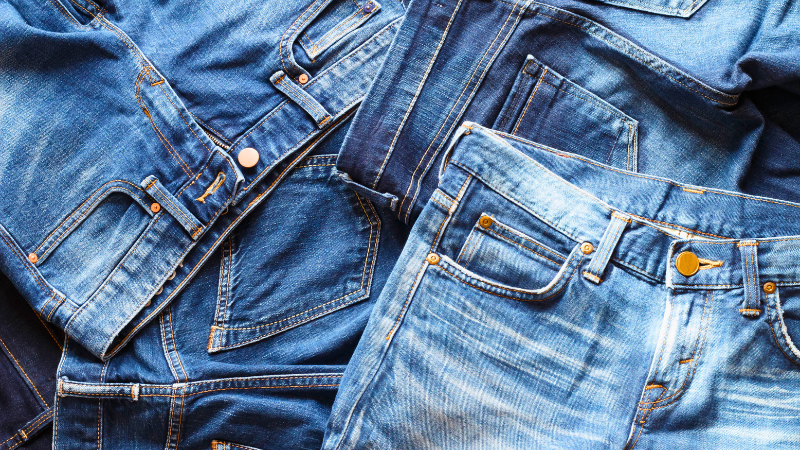
Both acid wash and stone wash processes use either chemicals or machines to quickly get the faded, worn look and a softer texture of denim. They are used in making new jeans look old and relaxed. As well as being used in jeans, this fabric matches well with relaxed tops and dresses.
Type | Feel | Durability | Appearance | Best For |
Raw Denim | Stiff | Very Durable | Dark, fades uniquely | Jeans lovers, collectors |
Selvedge Denim | Firm | Superior | Finished edges | High-quality jeans |
Stretch Denim | Flexible | Moderate | Smooth, stretchy | Casual wear, fitted jeans |
Washed Denim | Soft | Moderate | Faded, vintage look | Everyday fashion |
From Denim Fabric to Jean Clothing
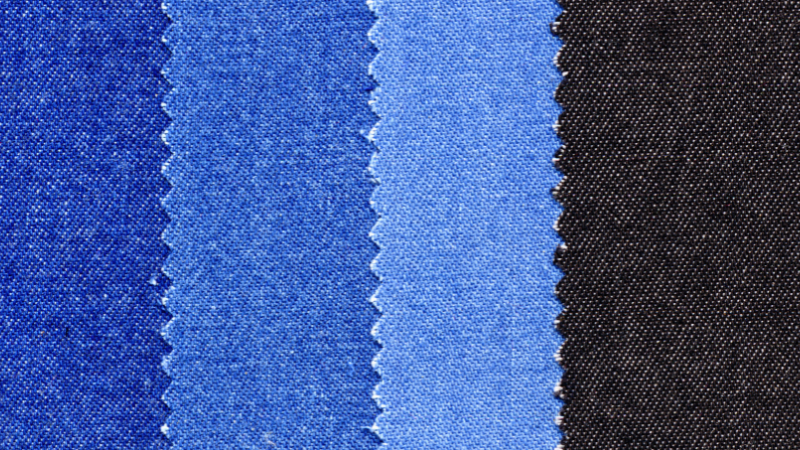
The process of making denim start with making sure that the stages of denim production are handled with care. The climb of Levi Strauss and denim jeans occurred in strong connection with American culture. At first created for use by miners and workers, denim soon became associated with being a countercultural symbol among the young.
Following the machine’s weaving of the warp and weft yarns, the denim textile is then cut, sewn and additional rigidity is added with rivets and buttons. The result of the production process includes accessories, jackets, shirts and skirts which all show how easily the fabric works for all of these items.
Pros and Cons of Denim
As with other fabrics, denim also has advantages as well as disadvantages. Being aware of these can lead you to choose if denim suits you for your style.
Pros
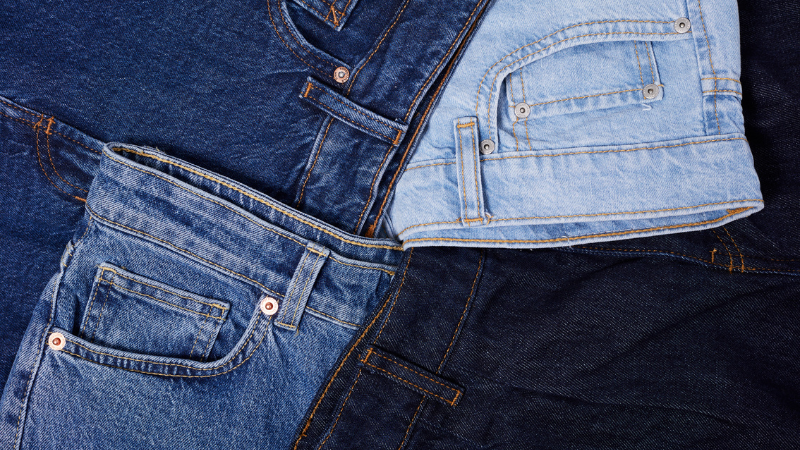
- Extremely long-lasting and very sturdy: Because denim is woven tight in its twill weave, it becomes very strong. So, your jeans or jacket are able to take on regular wear, energetic activities and lots of use without tearing too soon. Buying jeans is like buying pieces of clothing that will stay in your wardrobe for a long time.
- Has a sleek design: Being blue and textured, denim looks classic and can be worn in many different ways. You can go from office casual with a crisp shirt to a weekend look with a graphic tee and either way, your denim natural fiber adds style. It keeps its popularity and works well for every season.
- Breathable: Even though denim is quite thick, the cotton in it allows it to stay breathable. With breathability, your body can handle both cool and warm temperatures, since the clothes help manage your body temperature. Athletic clothing is tough but still feels good to wear.
- Gets more comfortable as you continue to use them: Denim is different because it gets better-looking as time goes on. With lots of use, the jean fabric adapts to your body and gets softer so you feel more comfortable. So, your old pair of jeans or jacket just keeps getting better and makes you happier the more time goes by.
Cons
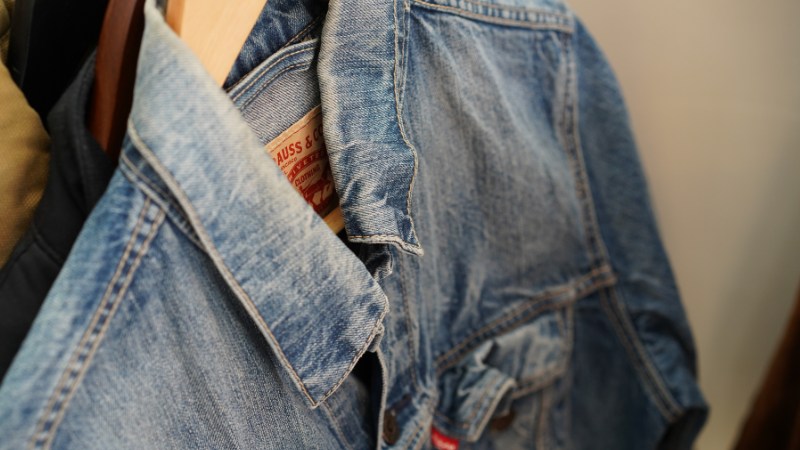
- Often feels heavy, mainly when it’s new or just out of the bag: Since denim is strong and tightly made, new denim feels stiff and heavy at first. In addition, wet denim keeps the water in and becomes heavy, which might not feel good. Maybe heaviness is not perfect if you are after something light to wear in summer.
- Requires time to become softer: You will find raw denim is not very comfortable at first and you have to wear them a lot before they soften. The idea of this step is to wear your jeans often without cleaning, which allows the denim to fit and shape the wearer’s body. Many people notice that new raw denim is both tight and not super comfortable to wear at first.
- Tends to dry out of the washing machine gradually: Because of its weight, denim remains wet for a greater period than many other fabrics. Air-drying your clothes takes more time, which can make your clothes uncomfortable if not dry after a fast cycle or in a damp state. Reaching a better result in your denim depends on planning how long the jeans should stay wet.
- May change size for the worse with lack of care: Denim shrinks during washing or drying when the heat is too high and this is due to the main material of cotton. Washing in cold water and air drying are the best ways to stop this from happening. Look after your jeans or jacket properly to keep them fitting the way they are for years.
How to Care for Denim Clothing
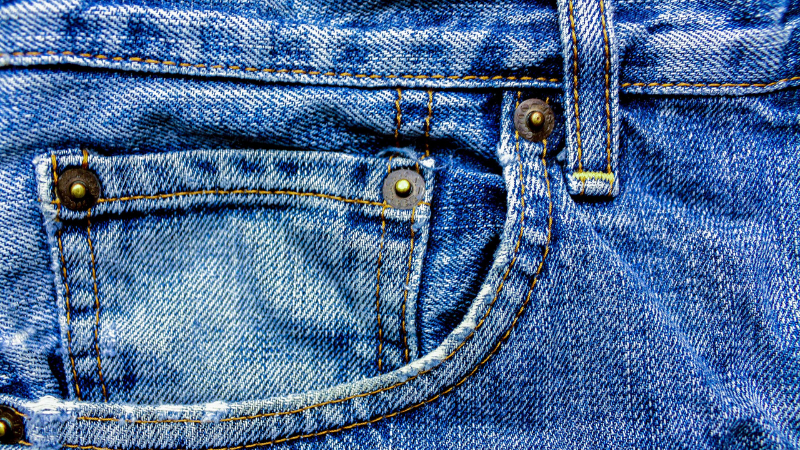
Denim jeans and jackets can be well taken care of by following just a few simple steps.
- Reduce the number of times you wash a week: If you are washing laundry your jeans regularly, the color and shape will be lost much faster. Wash yourself only when it is really necessary.
- Cover cereal tear stains with water that is cool: Using cold water can stop the indigo dye from fading as quick as it would in warm water.
- Put your garments inside out: This helps the color on the outer finish not fade or mark.
- Hang dry: Don’t put denim in the dryer, since denim can become too tight and its fibers can tear.
- Don’t use strong chemical products: Wash your colored sweaters with soft detergents made for colored textiles.
Denim vs Other Cotton Fabrics
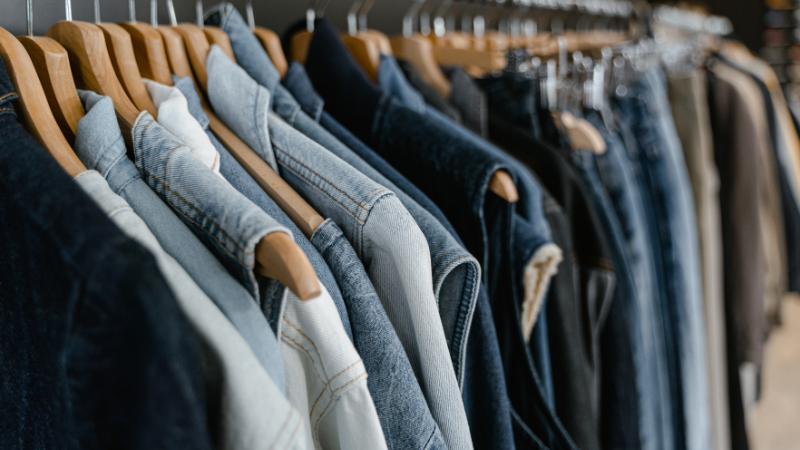
It’s possible to ask why denim is different from cotton fabrics. Let’s have a quick check:
Fabric | Weave Type | Durability | Feel | Common Uses |
Denim | Twill | Very High | Firm and sturdy | Jeans, jackets, workwear |
Canvas | Plain weave | Very High | Rough and heavy | Bags, shoes, outdoor gear |
Twill | Twill | Moderate | Softer than denim | Dress pants, uniforms |
Corduroy | Twill with diagonal ribbing | Moderate | Soft, ridged | Pants, jackets, upholstery |
Because denim is a strong material, it tends to fade in a way that makes every garment stand out. Hence, cotton gets an admirer base for its casual and long-lasting nature.
Final Thoughts: Why Denim Is More Than Just Jean Fabric
Denim can be comfortable, flexible and tough, which makes it useful in ways besides making jeans. Denim items like trousers, pants and coats look good in any style and age over time. We supply various woven and knitted fabrics, for example denim, to major international fast-fashion companies. The things we focus on are quality, innovation and sustainability.
Strict quality controls and certificates are used to guarantee every jean fabric you get meets your needs. The team here assists you through the process to give you the fabrics you need within the arranged time and price. Select Suzhou Yanmao Textile as the trustworthy company you work with for jean fabric.





